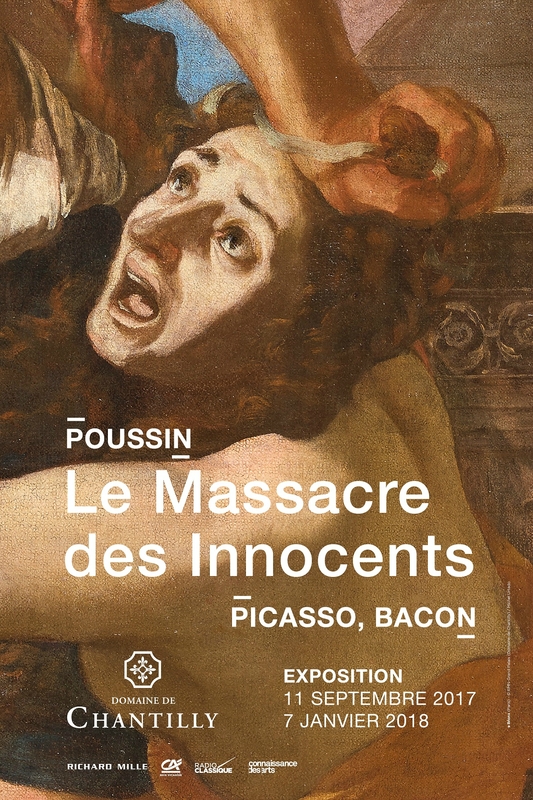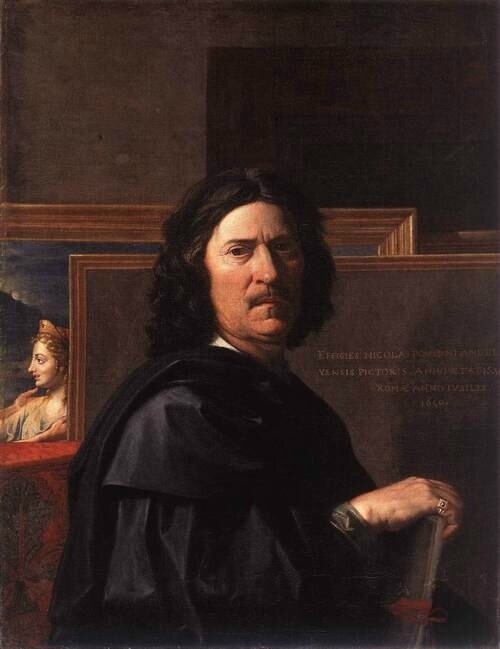Poussin, Le Massacre des Innocents au Domaine de Chantilly
PARIS - Du 11 septembre 2017 au 7 janvier 2018, Le Massacre des Innocents, chef-d’œuvre de Nicolas Poussin, sera la pièce maîtresse d’une exposition-événement au Domaine de Chantilly. De sa genèse à sa postérité, l’œuvre se révèlera à travers des prêts prestigieux et côtoiera de grands noms de l’art moderne et contemporain dont Pablo Picasso, Francis Bacon ou Annette Messager. Une première pour Chantilly !
Le musée Condé du Domaine de Chantilly possède, après le Louvre, le plus bel ensemble de tableaux et de dessins de Nicolas Poussin (1594-1665) conservé en France. Au sein de cette collection exceptionnelle, Le Massacre des Innocents (vers 1627-1628) se démarque tant par ses illustres propriétaires (Vincenzo Giustiniani, Lucien Bonaparte, le duc d’Aumale…) que par le traitement radicalement nouveau du sujet tiré du Nouveau Testament. L’exécution, ordonnée par le roi Hérode, de tous les enfants de moins de deux ans de la région de Bethléem, est en effet un sujet très courant dans l’art du XVIIe siècle. Auprès de ses contemporains, l’œuvre fait déjà sensation.
L’opposition entre la violence et la brutalité anonyme du bourreau ainsi que le désespoir et l’épouvante de la mère dont le cri est inoubliable, la tension brûlante, bouleversante du récit, ont de tout temps retenu l’attention par leur actualité ce qui explique la fortune du tableau qui a été copié par bien des artistes – citons Fragonard – et a inspiré les plus grands (Pablo Picasso, Francis Bacon, Henri Cueco, Ernest Pignon-Ernest).
Cette exposition, qui se tiendra dans la salle du Jeu de Paume du Domaine de Chantilly, se concentrera sur le chef-d’œuvre de Nicolas Poussin. À travers une cinquantaine d’œuvres, elle mettra en lumière sa postérité en accordant une large place à l’art moderne et contemporain.
Le visiteur découvrira tout d’abord l’histoire du tableau et de ses propriétaires, de son commanditaire italien, le marquis Vincenzo Giustiniani (1564-1637) au duc d’Aumale (1822-1897), de Rome à Chantilly en passant par Londres. Puis le chef-d’œuvre, en majesté, sera confronté à des grands maîtres du XVIIe siècle (Guido Reni, Pietro Testa), à une version antérieure du tableau provenant du Petit Palais et à un dessin préparatoire.
Le parcours se poursuivra par différentes interprétations allant du XVIIIe au début du XIXe siècle (Jean-Baptiste-Marie-Pierre, Léon Cogniet). Les dernières salles montreront les relectures modernes et contemporaines du Massacre des Innocents. Le Charnier (1945) de Pablo Picasso, côtoiera Head II (1949) de Francis Bacon. Des œuvres d’artistes contemporains ayant joué le jeu de l’appropriation (Henri Cueco, Jean-Michel Alberola…) seront présentées à touche-touche, évoquant l’accrochage XIXe du musée Condé. Enfin, des propositions inédites d’Annette Messager, Pierre Buraglio ou Jérôme Zonderdémontreront toute la force et l’actualité du chef-d’œuvre de Chantilly.
Nicolas Poussin, Le Massacre des Innocents, Vers 1627 - 1628. Huile sur toile H. 148,5 cm; L. 174,5 cm © RMN - Grand Palais - Michel Urtado.
PARIS.- From 11 September 2017 to 7 January 2018, Poussin’s masterpiece Le Massacre des Innocents, will be the highlight of a landmark exhibition at the Domaine de Chantilly. From it origins to its posterity, the work will unveil its mysteries through prestigious loans and will hang side by side with great names of modern art, among whom Pablo Picasso, Francis Bacon and Annette Messager. A premiere at Chantilly!
The timelessness and relevance of a masterpiece
The Domaine de Chantilly’s musée Condé owns the finest ensemble of paintings and drawings by Nicolas Poussin (1594-1665) in France, after the Louvre. In this exceptional collection, Le Massacre des Innocents stands out both because of its illustrious owners (Vincenzo Giustiniani, Lucien Bonaparte, the duc d’Aumale…) and because of the radically innovative treatment of the subject drawn from the New Testament. The execution commanded by King Herod of all male children aged under two in the region of Bethlehem was a very common subject in 17th century art. This work greatly impressed its contemporaries; the contrast between the violence and the anonymous brutality of the executioner and the despair and horror expressed by the mother in an unforgettable scream, as well as the poignant and overwhelming tension of the story have attracted the public’s attention through times because of its timeless relevance. This is what explains the painting’s fortune and the fact that it has been copied by numerous artists - Fragonard among them - and has inspired the greatest (Pablo Picasso, Francis Bacon, Henri Cueco, Ernest Pignon-Ernest).
Modern and contemporary art on display for the first time at the Domaine de Chantilly
This exhibition in the Salle du Jeu de Paume of the Domaine de Chantilly will focus on Nicolas Poussin’s masterpiece. Around fifty works will highlight its posterity, giving pride of place to modern and contemporary art. Visitors will first discover the history of the painting and of it owners, from Marchese Vincenzo Giustiniani (1564-1637) who commissioned it, to the duc d’Aumale (1822-1897), from Rome to Chantilly through London. The masterpiece will then be confronted to great 17th century masterpieces (Guido Reni, Pietro Testa) and to an earlier version of the painting from the Petit Palais and a preparatory drawing.
The exhibition will continue with different interpretations of the subject from the 18th to the beginning of the 19th century (Jean-Baptiste Marie Pierre, Léon Cogniet). The last rooms will show modern and contemporary reinterpretations of the Massacre des Innocents. Pablo Picasso’s Charnel House (1945), returning to France for the first time since 1954, will hang alongside Head II (1949) by Francis Bacon. Works by contemporary artists who have played the appropriation game (Henri Cueco, Jean-Michel Alberola…) will be presented side by side, in close proximity, in the style of the 19th century hanging of the musée Condé. Finally new propositions by Annette Messager, Pierre Buraglio and Jérôme Zonder will highlight the strength and the relevance of Chantilly’s masterpiece today.
Poussin, Study for the Massacre of the Innocents II, 1628-29. Pen, brown ink and wash on paper, 147 x 169 mm, Musée des Beaux-Arts, Lille.
Portrait de l'artiste Nicolas Poussin, 1649 ©RMN-Grand Palais (musée du Louvre) / Jean-Gilles Berizzi.

/https%3A%2F%2Fprofilepics.canalblog.com%2Fprofilepics%2F1%2F0%2F100183.jpg)
/https%3A%2F%2Fstorage.canalblog.com%2F03%2F02%2F119589%2F96711876_o.jpg)
/https%3A%2F%2Fstorage.canalblog.com%2F11%2F31%2F119589%2F94773502_o.jpg)
/https%3A%2F%2Fstorage.canalblog.com%2F20%2F83%2F119589%2F94772815_o.jpg)
/https%3A%2F%2Fstorage.canalblog.com%2F26%2F72%2F119589%2F75604929_o.jpg)
/https%3A%2F%2Fstorage.canalblog.com%2F59%2F60%2F119589%2F26458628_o.jpg)






/image%2F1371349%2F20240423%2Fob_981d5f_h22891-l367411650-original.jpg)
/http%3A%2F%2Fstorage.canalblog.com%2F96%2F49%2F119589%2F129580191_o.png)
/http%3A%2F%2Fstorage.canalblog.com%2F40%2F31%2F119589%2F128509350_o.jpg)
/http%3A%2F%2Fstorage.canalblog.com%2F92%2F57%2F119589%2F127733091_o.jpg)